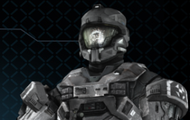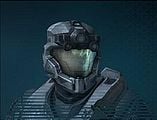OPERATOR-class Mjolnir
From Halopedia, the Halo wiki
Template:Armor Infobox The MJOLNIR Powered Assault Armor/Operator variant, commonly known as the Operator armor, is a variant of the Mark V MJOLNIR armor and MJOLNIR (GEN2) armor.[1][2] The Mark V variant was designed for use by Spartan operators within the ONI Beta-5 Division's Asymmetrical Action Group.[1][3]
Overview
GEN1
While the non-Spartan members of the Asymmetrical Action Group wear their own standard-issue armor, the Beta-5 Division contracted Chalybs Defense Solutions to develop a MJOLNIR variant designed to improve the performance of the AAG's Spartan personnel. The armor, which was jointly developed at the Beta-5 Division Ordnance Testing Facility and at Chalybs' Testing Preserve, and was tested at the latter location,[note 1] can provide the wearer with detailed, on-the-fly intelligence through secure transmissions that can bypass most Covenant security networks.[1]
The standard version of the helmet features a B5D-O/Optics suite,[1] which is mounted on the forehead. The UA/HUL variant replaces the standard optics suite with an up-armor plate featuring a Hardened Uplink Module on the left side. Another variant, which is issued to unit commanders,[3] features Command Network Module-Improved on the right side.
The Operator systems's shoulder pauldrons are simply armored bands mounted on the user's base shoulder guards, with two string-like attachments descending from the bottom. There is a geometrical pattern emblazoned on the plate as well.
Joshua-029 wearing a Mark IV variant of the armor during the Battle of Sigma Octanus IV.
GEN2
Template:Article Quote Sometime after the Fall of Reach, the Operator armor was taken over by the Naphtali Contractor Corporation, after the abandonment of all CDS facilities on Meridian, and was tested extensively with live fire exercises in the NCC's abandoned shipyards on the outskirts of Abilene.[4] Unlike its predecessor, it optimizes a Spartan for the operation and control of vehicles.[2]
In-game information
Halo: Reach
Helmet
Developed exclusively for the ONI's Beta-5 Asymmetrical Action Group.
Base Price: 7,000 cR, Sergeant
- Description: The B5D Facility has been the site of many unique development programs
UA/HUL Price: 2,500 cR, Sergeant
- Description: Up-armored varient with hardened uplink module for MILINT acquisition.
CNM Price: 1,000 cR, Sergeant
- Description: Command network module; standard issue to UNSC Special Forces unit commanders.
Shoulders
Price: 28,000 cR, Commander
- Description: Developed for the Beta-5 Asymmetrical Action Group at ONI's Ordnance Testing Facility.
Halo 4
Unlock: Available at Spartan Rank OP-4
- Description: Tested in the NCC's adandoned shipyards on the outskirts of Abilene.
Available skins: SRFC (Surface)
- The SRFC skin is obtainable at Spartan Rank OP-9
Halo 5: Guardians
Unlock: Rare REQ card
- Helmet description: OPERATOR visor plates include hyperspectral optical sensors, though the sensor fusion software that would tie that information into VISR has yet to be finalized.
- Armor description: OPERATOR armor has proven itself an adaptable combat ensemble in Spartan service, utilized by both pilots and force reconnaissance operatives.
Trivia

|
Browse more images in this article's gallery page. |
- The helmet looks very similar to an updated concept of the MJOLNIR armor drawn by Eddie Smith which is featured in The Art of Halo.
- Although the Operator armor is used solely by the Asymmetrical Action Group, Emile-A239 wore an Operator shoulder piece on his left shoulder.
Gallery
- OperatorSitting.jpg
A Spartan sitting in a Pelican while wearing an Operator helmet.
The Operator armor featured in Halo 4.
Hoya wearing the GEN2 Operator armor.
Halo Online skin available for taking part in Halo Online Beta.
List of appearances
- Halo: Reach (First appearance)
- Halo 4
- Halo: Initiation
- Halo: Escalation
- Halo: Fleet Battles
- Halo 5: Guardians
- Halo Online
Note
- ^ According to the Armory in Halo: Reach, the Operator armor was developed at the Beta-5 Division Ordnance Testing Facility. According to Halo: The Essential Visual Guide, the armor was developed by Chalybs Defense Solutions and was tested at Chalybs' Testing Preserve. The article assumes that the two organizations jointly developed the armor.
Sources
- ^ a b c d Halo: The Essential Visual Guide, page 133
- ^ a b Halo Waypoint: The Halo Bulletin 8.15.2012
- ^ a b Halo: Reach, The Armory
- ^ Halo 4






